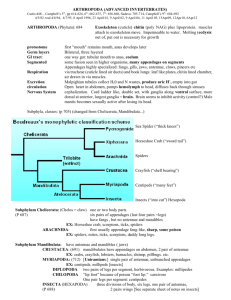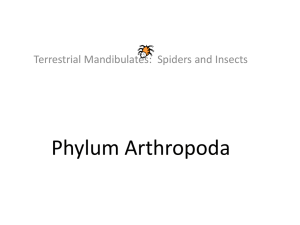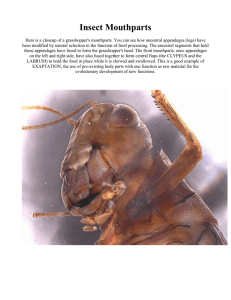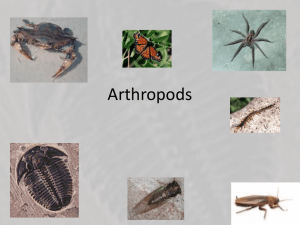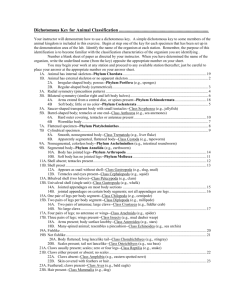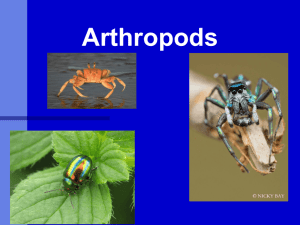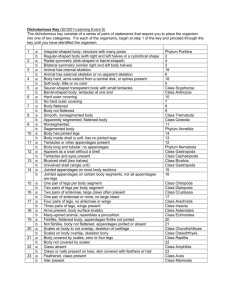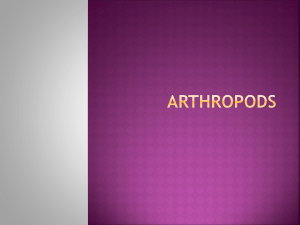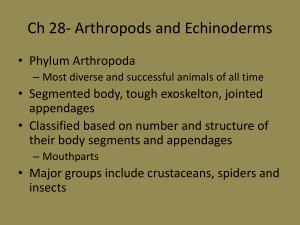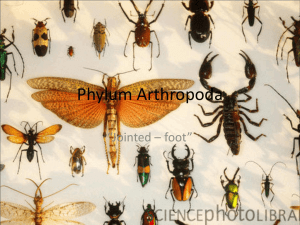Arthropoda--post
advertisement
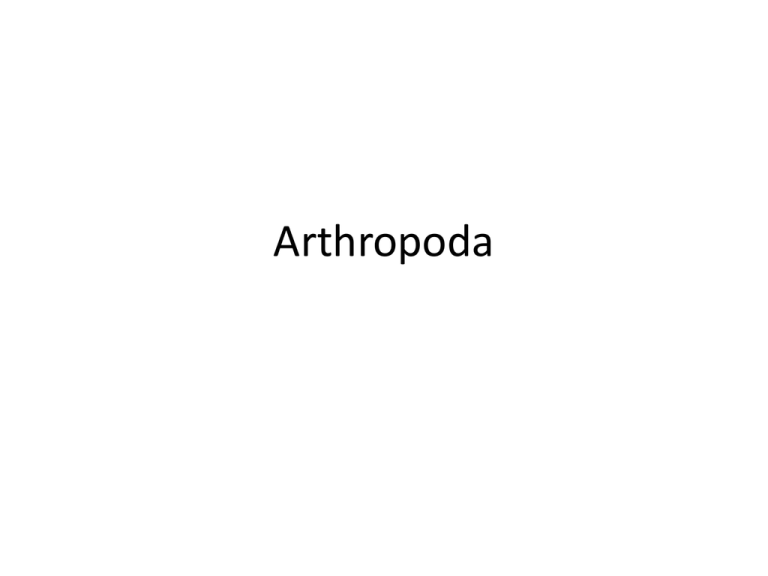
Arthropoda Characteristics of Arthropoda • Segmented body (tagma & tagmatization) • Hard exoskeleton (cuticle)of chiton + protein • Paired, Jointed appendages – Legs, antennae, feeding parts Exoskeleton • Can be thick/rigid or thin/flexible • Functions: – – – – Structural support Muscle attachment Protection Prevents/reduces desiccation • Facilitated colonization of land • Must be molted • Energetically costly Arthropod Systems Well developed sensory systems • Eyes that produce visual images (compound & simple) • Chemo (olfactory receptors) • Inc. antennae which function as both chemo and tactile receptors Open circulatory system • Hemocoel is main body cavity Respriatory system • Aquatic typically gills • Terrestrial internalized tubes – Tracheal system – Book lungs Diversity 3 lineages, 4 main sub-phyla • Chelicerata • Myriapodia • Pancrustaceans – crustaceans – Hexapoda (inc. insects) Chelicerates (spiders, horseshoe crabs, scorpions, ticks, mites): • Chelicerae – Feeding appendages (fangs or “claws”) • pedipalps – sensing, reproduction, defense, manipulating food • 2 body segments – cephalothorax & abdomen • Simple eyes (single lens) (often multiple • No antennae • uniramous Figure 33.32 50 µm Scorpion Dust mite Web-building spider Arachnids (chelicerates) Appendages • 4 pairs of walking legs • chelicerae—fangs which posses poison glands • Toxin contains digestive enzymes that soften & semi digest the tissues of prey and then they are slurped up the slurry. • Pair of pedipalps Book lungs • Internalized, highly branched from lots of gas exchange. • Stacked plates with spaces between, hemolymph flows next to spaces Silk and webs: • protein produced by glands in the abdomen • spun by spinerette • Each species produces a unique web and the spiders innately know how to create it –genetically determined behavior Myriapods — millipedes and centipedes • • • All living examples are terrestrial Uniramous legs Head segment: 1 pair of antanae, 3 pairs of appendages that are modified into mouthparts which includes the jawlike mandible Millipedes: • Two pairs of legs/segment • They are detrivores and/or herbivores • Rounded in cross section Centipedes • One pair of legs/segment • Dorsoventrally flattened • Carnivores – Poison claws (maxillaped) on the 1st trunk segment that paralyze prey and help in defense Crustaceans (crabs, lobsters, shrimp, krill, barnacles, isopods, copepods) exp. decapod • Freshwater, marine, and some terrestrial Appendages • Biramous appendages • Two pairs of antennae • Walking legs on thorax • Swimmerets on abdomen (marine versions only) Segments: • Cephalothorax – Carapace w/ calcium carbonate • abdoman Crustaceans (crabs, lobsters, shrimp, krill, barnacles, isopods, copepods) exp. decapod Gas exchange • Small ones cuticle • Larger gills Reproduction: aquatic crustanceans have larval stages • Crustacean larvae help form a large part of the zooplankton • Some adults (copepods) are also part of plankton Barnacles—cuticle with calcium carbonate (refered to as a shell) • Filter feeders filter with feeding appendages • Glue themselves to substrate Cephalothorax Antennae (sensory reception) Abdomen Thorax Head Eye Swimming appendages (one pair per abdominal segment) Pincer (defense) Mouthparts (feeding) Walking legs Figure 33.36 Hexapoda (6 legged arthropods – includes insects) Appendages • Antennae • 3 pairs of walking legs • uniraous Segments • 3 parts – Head – Thorax • Many with two pairs of wings • Extensions of exoskeleton, not limbs • Adaptive advantage of flight • Abdomen Reproduction: • Dioecious • Internal fertilization • Sperm in spermatheca, fertilize egg at later time • Incomplete v.complete metamorphosis Abdomen Thorax Head Compound eye Figure 33.38 Antennae Heart Dorsal artery Crop Cerebral ganglion Anus Vagina Malpighian tubules Ovary Tracheal tubes Nerve cords Mouthparts • Tracheal system Pores on surface trachea tracheoles tissues (perfuses all tissues) • Air sacs • Both gas exchange and gas transport • No hemolymph involved Malphigian Tubules • Terrestrial arthropods • Closed tubes in hemoceol • Actively transport waste and ions (no filtration) • Water follows osmotically • Connects to rectum • Rectum reabsorbs water and ions • Nitrogenous waste (uric acid) released as solid w/ feces Video: Butterfly Emerging Figure 33.40 (a) Larva (caterpillar) (b) Pupa (c) Later stage (d) Emerging pupa adult (e) Adult Archaeognatha (bristletails; 350 species) Figure 33.41 Zygentoma (silverfish; 450 species) Winged insects (many orders; six are shown below) Complete metamorphosis Coleoptera (beetles; 350,000 species) Diptera (151,000 species) Hymenoptera (125,000 species) Proboscis Lepidoptera (120,000 species) Incomplete metamorphosis Hemiptera (85,000 species) Orthoptera (13,000 species) • Consult your lab guide for selected details about specific insect orders
